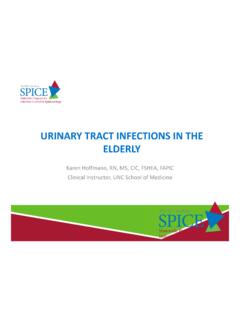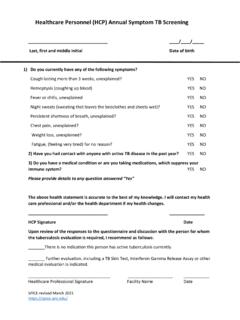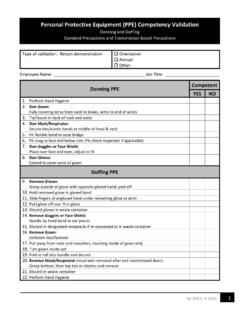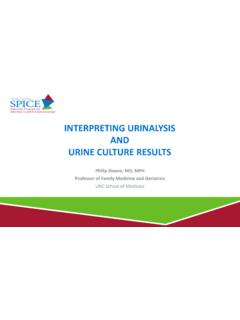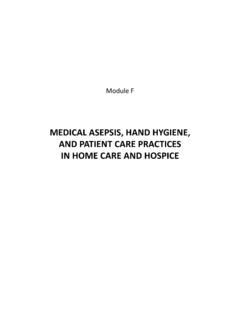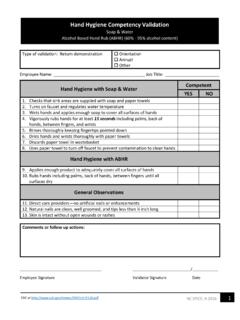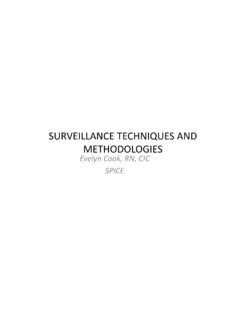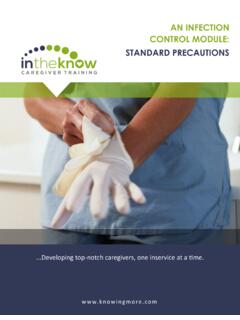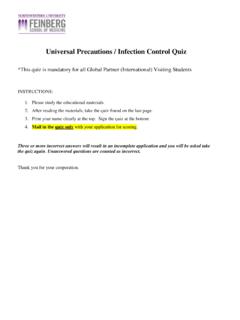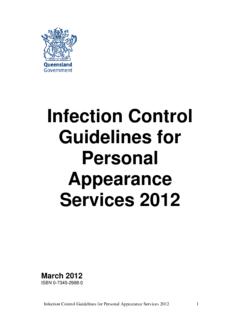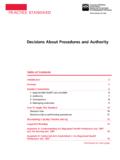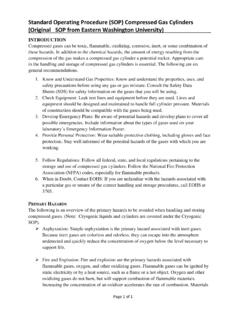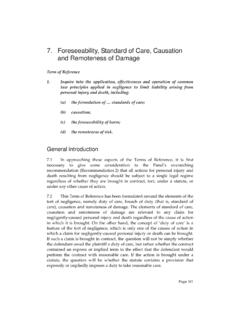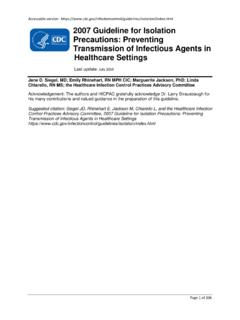Transcription of ISOLATION PRECAUTIONS in Healthcare Settings
1 ISOLATION PRECAUTIONSK aren Hoffmann RN, MS, CIC, FSHEA, FAPIC 2006 Management Of Resistant Organisms In Healthcare Settings2007 Guideline for ISOLATION PRECAUTIONS : Preventing Transmission of Infectious Agents in Healthcare Settings Jane D. Siegel, MD; Emily Rhinehart, RN MPH CIC; Marguerite Jackson, PhD; Linda Chiarello, RN MS; the Healthcare Infection Control Practices Advisory Committee Inclusion of non-hospital Settings Re-emphasis on Standard PRECAUTIONS Safe injection Practices Respiratory hygiene practices Use of mask during spinal proceduresKEY CONCEPTS Risk of transmission of infectious agents occurs in all Settings Infections are transmitted from patient-to-patient via HCPs or medical equipment/devices ISOLATION PRECAUTIONS are only part of a comprehensive IP program Unidentified patients who are colonized or infected represent risk to other patientsFUNDAMENTAL ELEMENTS Administrative support Adequate Infection Prevention staffing Good communication with clinical microbiology lab and environmental services A comprehensive educational program for HCPs, patients, and visitors Infrastructure support for surveillance, outbreak tracking.
2 And data managementSTANDARD PRECAUTIONSS tandardComponentRecommendationHand HygieneAfter touching blood, body fluids, secretions, excretions, contaminated items; immediately after removing gloves; between patient contacts. Personal Protective Equipment (PPE)GlovesFor touching blood, body fluids, secretions, excretions, contaminated items; for touching mucous membranes and non-intact skin(Hand Hygiene before and after glove removal unless for environmental cleaning) GownDuring procedures and patient-care activities when contact of clothing/exposed skin with blood/body fluids, secretions, and excretions is anticipated Mask, eye protectionDuring procedures and patient-care activities likely to generate splashes or sprays of blood, body fluids, secretions, especially suctioning, endotracheal intubation ComponentRecommendationSoiled equipmentHandle in a manner that prevents transfer of microorganisms to others and to the environment; wear gloves if visibly contaminated.
3 Perform hand hygiene Environmental ControlDevelop procedures for routine care, cleaning, and disinfection of environmental surfaces, especially frequently touched surfaces in patient-care areas LaundryHandle in a manner that prevents transfer of microorganisms to others and to the environment Needles and sharpsOne patient one needle one syringe and HCP use masks for spinal injections. Patient ResuscitationUse mouthpiece, resuscitation bag, other ventilation devices to prevent contact with mouth and oral secretions ComponentRecommendationPatient placement Prioritize for single-patient room if patient is at increased risk of transmission, is likely to contaminate the environment, does not maintain appropriate hygiene, or is at increased risk of acquiring infection or developing adverse outcome following infection. Respiratory hygiene/cough etiquette (source containment of infectious respiratory secretions in symptomatic patients, beginning at initial point of encounter) Instruct symptomatic persons to cover mouth/nose when sneezing/coughing; use tissues and dispose in no-touch receptacle; observe hand hygiene after soiling of hands with respiratory secretions; wear surgical mask if tolerated or maintain spatial separation, >3 feet if possible;Post signage at the points of entry to the facility during periods of increased community respiratory diseases.
4 TRANSMISSION BASED PRECAUTIONS (TBP)CHAIN OF INFECTION Imag result for chain of infection pictureRATIONALE BEHIND TRANSMISSION BASED PRECAUTIONSI nfectionSourceHostTransmissionSOURCES OF INFECTIONH umanPatientsHealthcare PersonnelVisitors/household membersEnvironmentalCommon VehiclesVectorborneHost FactorsAgeImmobilityIncontinenceDysphagi aChronic DiseasesPoor Functional StatusMedicationsIndwelling devicesROUTES OF TRANSMISSION Direct Contact Indirect Contact Aerosol DropletDIRECT AND INDIRECT CONTACT TRANSMISSIOND irect Contact: Skin to skin touchingIndirect Contact: inanimate surfaces DROPLET AND AIRBORNE TRANSMISSIONT ypes of TransmissionBased PRECAUTIONS :Airborne PrecautionsDroplet PrecautionsContact PrecautionsDOFFING AND DUFFING PPE: 1 protocol deviation in 27% EVD; 50% CPDoffing PPE:1 protocol deviation in100% EVD; 67% CPFluorescence detected: for EVD 44% EVD; 28% CPKwon JH, et al.
5 Assessment of HCWs Protocol Deviations and Self-Contamination During Personal Protective Equipment Donning and Doffing. ICHE. September contaminated almost 80% of the PPE , et al. Use of personal protective equipment among health care personnel: Results of clinical observations and simulations.(2017) 3. Mannequin simulated BBF with UV-fluorescent tracersPoller B, et al. A fluorescence-based simulation exercise for training HCW in the use of personal protective equipment, Journal of Hospital Infection 2018,4. HCP (ICU) 39% error doffing, 36% MDRO contaminated Di Fiore et al, Improper Removal of Personal Protective Equipment Contaminates HCWs ICHE, March mask prior to entryNo special ventilationPrivate room or CohortHand hygiene Residents use mask outside of roomCONDITIONS OR DISEASES REQUIRING DROPLET PRECAUTIONSD isease/ConditionDuration of IsolationInfluenzaFor 5 days from onset of symptoms or 24 hours without fever, which ever is longerMeningococcal Diseases.
6 Meningitis, pneumoniaFor 24 hours after treatment has startedMRSA pneumoniaFor duration of illness (also use Contact PRECAUTIONS )Strep ThroatFor 24 hours after treatment has startedRhinovirus (cold)For duration of illnessPrivate room onlyRoom requires negative airflow pressureDoors must remain closedVisual air monitorsEveryone must wear an N-95 respirator or higherLimit the movement and transport of the patientDisease/ConditionDuration of IsolationTuberculosis For 5 days from onset of symptoms or 24 hours without fever, which ever is longerChickenpoxFor 24 hours after treatment has startedVesicularFor duration of illness (also use Contact PRECAUTIONS )For 24 hours after treatment has startedFor duration of illnessCONDITIONS OR DISEASES REQUIRING AIRBORNE PRECAUTIONSC ontroversy No 1 Gown and gloves before or upon entry Disinfect shared equipmentControversy No. 2 Special enteric PRECAUTIONS for C.
7 Difficile and NorovirusDoes CDC recommendroutine handwashing with soap and water or ABHR?Controversy No. 2 Answer: Soap and water handwash (Ref. 2007 CDC ISOLATION PRECAUTIONS Guidelines) CDC recommends ABHR unless there is ongoing transmission or high endemic levels. (Ref. C. Diff Tool Kit)SPECIAL AIRBORNE/CONTACT ISOLATIONHIGHLY TRANSMISSIBLE PATHOGENS: EBOLANC SPICE COVIDRESPIRATORS-REUSEFDA/CDC-NIOSH Disease/ConditionDuration of IsolationEpidemiologically Significant -Anitbiotic Resistant Bacteria MRSA, VRE, , No. 3 Per MDRO guideline Clostridium difficile (C. diff)24-48 hours after symptoms resolveNorovirus48 hours after symptoms resolveScabies and Lice24 hours after treatment startedViral Conjunctivitis (pink eye)Until symptoms resolveCONDITIONS OR DISEASES REQUIRING CONTACT PRECAUTIONSDO ALL MDROS REQUIRE TRANSMISSION BASED PRECAUTIONS ? Epidemiologic significant pathogens - MDROs judged by the IPCP, based on local, state, regional, or national recommendations to be of clinical and epidemiologic significance.
8 Contact PRECAUTIONS recommended in Settings with evidence of ongoing transmission, acute-care Settings with increased risk for transmission or wounds that cannot be contained by dressings. Contact state health department for guidance regarding new or emerging CDC HICPAC ISOLATION - PRECAUTIONS Guidelines HOW EFFECTIVE ARE CONTACT PRECAUTIONS ?CONTROVERSY NUMBER 4 Unknown Ineffective MRSA if adherence is poor (20-30%) Afif W, et al. Am J Infect Control 2002;30:430-433 Cromer AL, et al. Am J Infect Control 2004;32:451-5 Most data from outbreak Settings Given extent of environmental contamination with some MDR-GNRs, barrier PRECAUTIONS make theoretical OF ACTIVE SURVEILLANCE- TIER 2 CDC RECOMMENDATIONS (Tier 2 recommendations) Targeted surveillance of high risk patients: Useful during outbreaks and when incidence of an MDR-GNR is rising or not declining despite routine control efforts Point prevalence surveys during outbreaks.
9 Define reservoir and guide control efforts Determine if on-going surveillance cultures neededCDC/HICPAC MDRO AND EMPIRIC APPLICATION OF TRANSMISSION-BASED PRECAUTIONS Diagnosis requires lab confirmation Culture-based lab test require 2 or more days PRECAUTIONS should be implemented while awaiting results Based on clinical presentation and likely pathogen Reduces transmission opportunitiesClinical Syndrome or ConditionPotential PathogensEmpiric PRECAUTIONS (always includes Standard PrecautionsDiarrheaAcute diarrhea with infectious cause in incontinent or diapered patientEnteric PathogensContact PrecautionsRash or Exanthems, generalized, unknown etiologyPetechial/Ecchmotic w/ feverNeisseria meningitidesDroplet PRECAUTIONS for 1st24hrs of antimicrobial therapyVesicularVaricella-zoster, herpes simplex, vaccinia virusesAirborne plus Contact precautionsRespiratory InfectionsCough/fever/upper lobe infiltrateTb, Respiratory Viruses, S.)
10 Pneumoniae, S. aureusAirborne PRECAUTIONS plus contactSkin or Wound InfectionAbscess or draining wound that cannot be coveredStaphylococcus aureus, group A streptococcusContact PrecautionsAdd Droplet for the first 24 hours of antimicrobial therapy if group A strep disease suspectedCOMMUNICATING PRECAUTIONSHow to prevent handoff problems during patient transfers intra-facility and inter-facility ( signage)? IMPLEMENTATION STRATEGIES FOR MDRO CONTROL COHORTING AS A CONTROL STRATEGY Single rooms first choice; cohorting second, and roommate that is not compromised or with risks (invasive devices). Cohorting of patients with same pathogen; Cohorting of staff; Cohorting by use of designated beds or units. UPDATE ON RECOMMENDATIONS FOR PRECAUTIONS FOR VISITORS Use guided by specific pathogen, underlying infectious condition and endemicity of the organism in hospital and communityInfection Control & Hospital Epidemiology / FirstView Article / April 2015, pp 1 - 12 ISOLATION PRECAUTIONS FOR VISITORS All visitors comply with hand hygiene before and after visiting Endemic situations with MRSA and VRE No Contact PRECAUTIONS for visitors in routine circumstances Visitors visiting multiple patients should use Contact PrecautionsISOLATION PRECAUTIONS FOR VISITORS Parents/guardians/visitors with extended stay in patient s room, Contact PRECAUTIONS are not practical.
